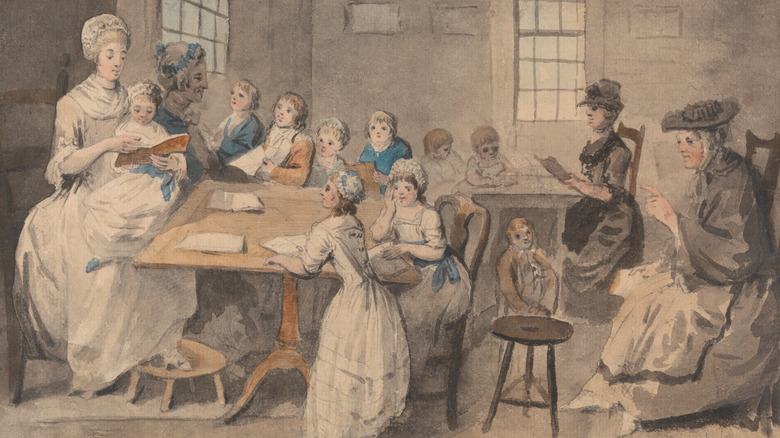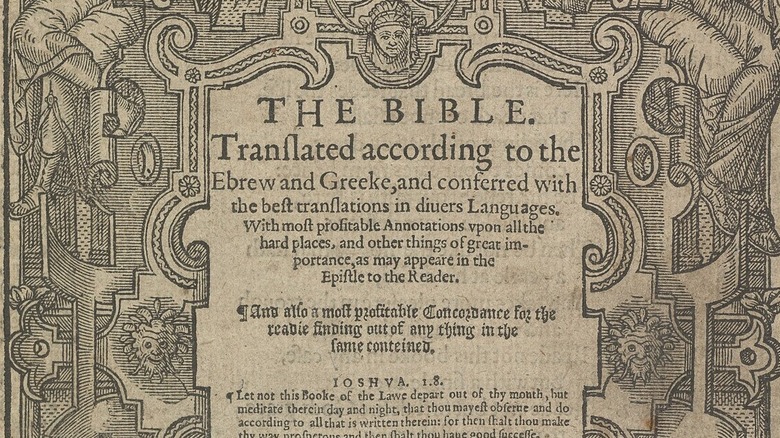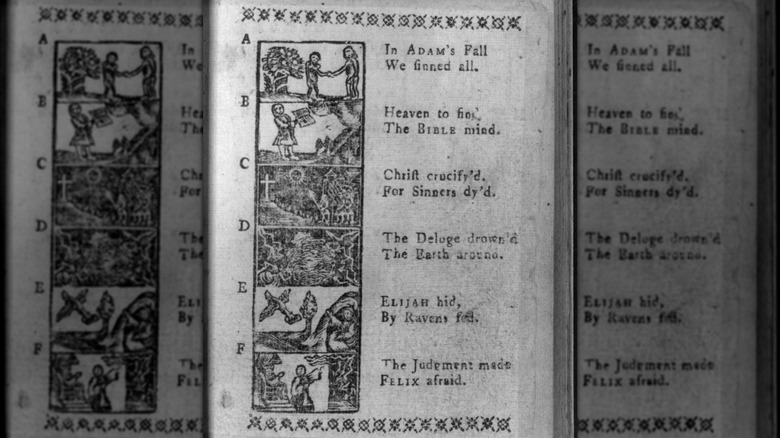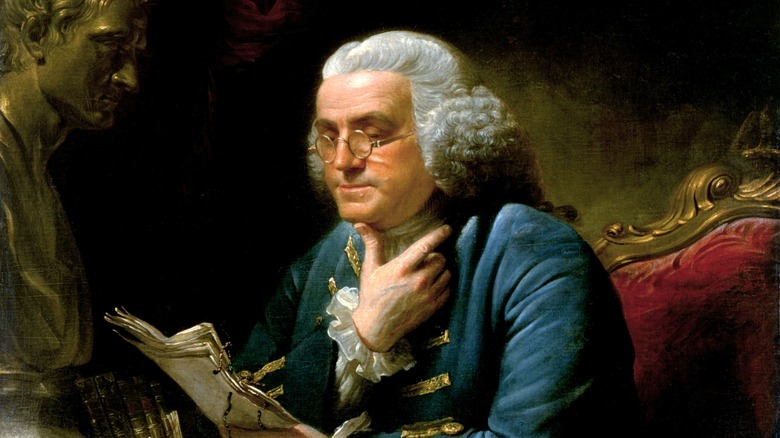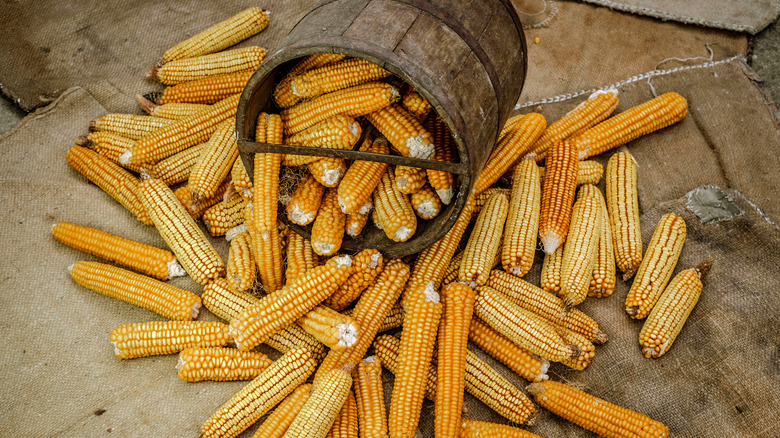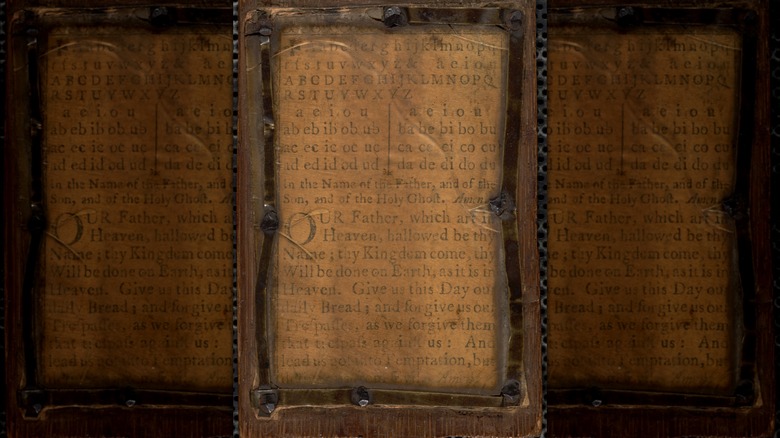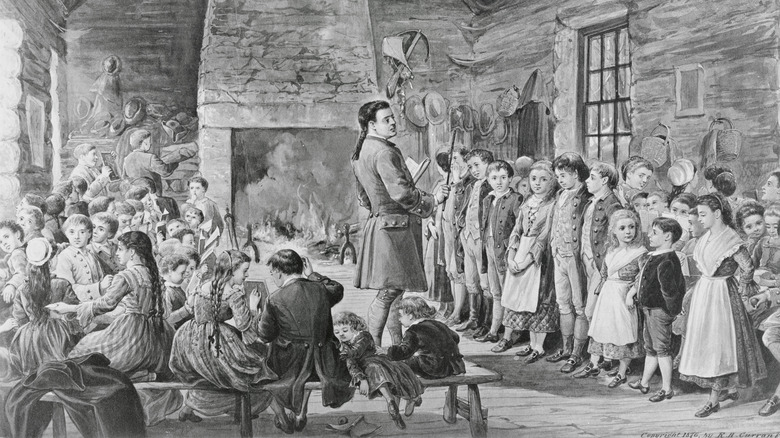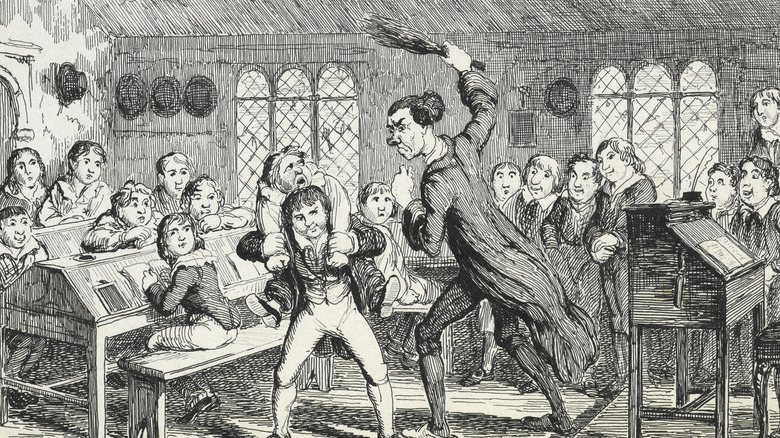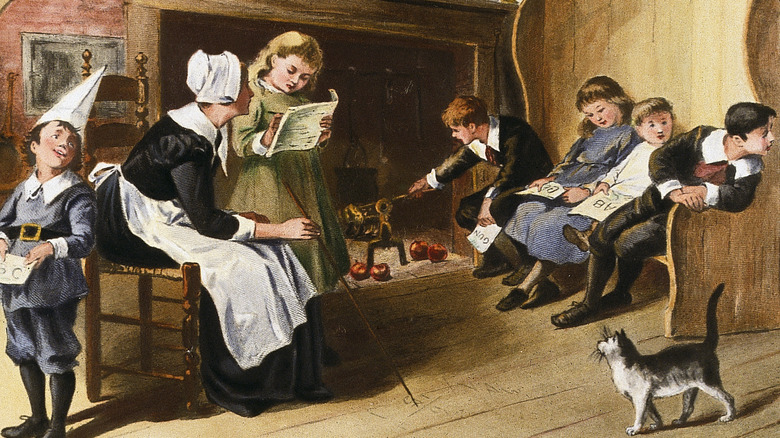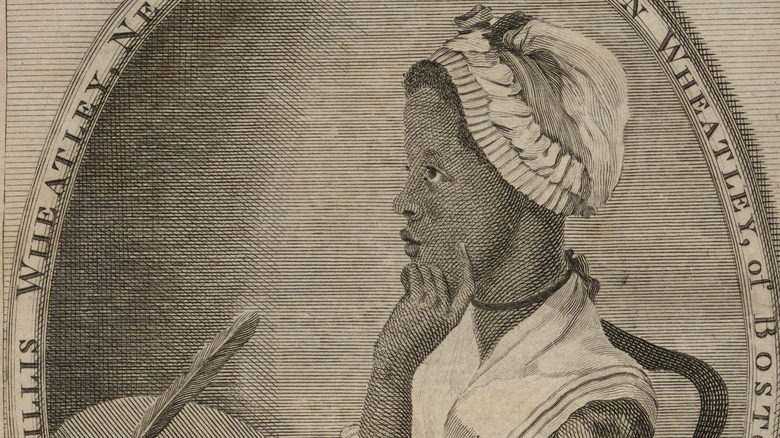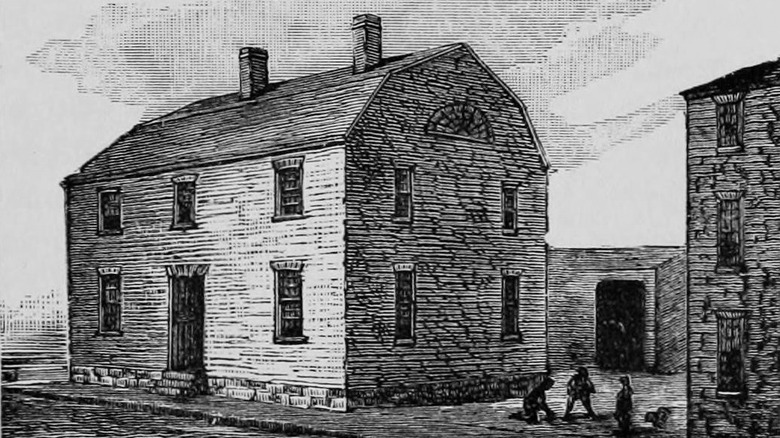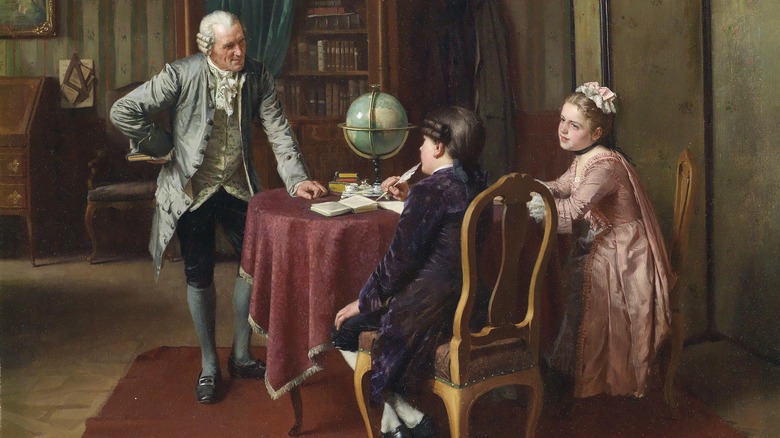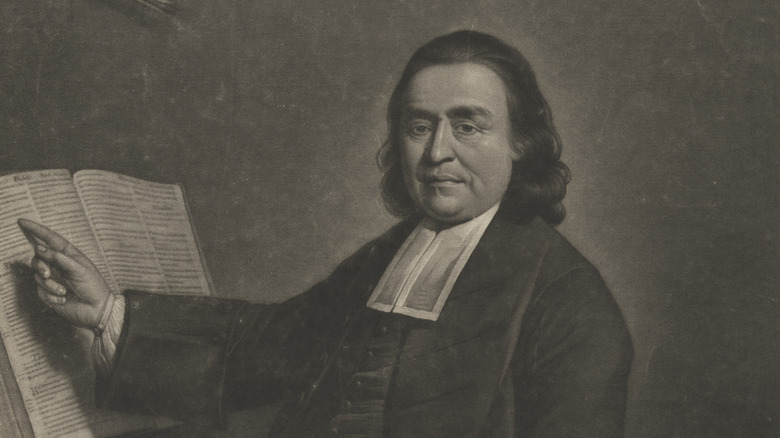What School Was Really Like During Colonial Times
The modern United States would likely be a very different place — or perhaps wouldn't exist at all — if it weren't for school. Literacy was of vital importance to the 17th-century Puritan settlers who made their way to New England to establish a religious colony far from the perceived indulgences of European Christianity. How else could they read the Bible for themselves if they and their children didn't know their letters? Later on in the colonial period, the highly educated Founding Fathers (of which George Washington was a notable self-taught exception) used their advanced learning and ties to the highly intellectual and secular Enlightenment to justify the American Revolution and the formation of a new nation.
School in the American colonies was a hodgepodge of teachers, buildings, and opportunities. Some students would have done most of their learning at home and more or less stopped there. Others, especially in places that required communities to provide for basic education, would have made it to a schoolroom, where instructors of varying quality taught them reading, math, and more. Those schoolmasters were also tasked with shaping their students into upstanding citizens — sometimes with the rather harsh application of a switch.
Some students made learning a facet of their lives, but many were required to take time off to help their families, especially during busy agricultural seasons. Others, like girls and Black students, faced serious barriers in the colonial education system. However it happened, the reality of colonial school may surprise you.
Early New England colonists prioritized literacy
Some of the earliest European settlers in New England made it their goal to ensure that most of those in their communities could read. For the Puritans, literacy was an obligation to God. To many, a priest reading out of a Latin Bible or sermonizing to an illiterate congregation was an affront to the Almighty. To do things right, one had to read the Bible on their own and take their faith into their hands.
So, in the early colonies controlled by Puritans, school buildings popped up seemingly everywhere and at a faster rate than nearly any other structure. Likewise, the Massachusetts colony passed the 1642 Massachusetts Compulsory Attendance Law, which required all children receive a basic education. Families and apprentice masters were also required to teach their young ones a useful trade. However, it didn't necessarily require them to leave the house and attend a separate school, leaving the members of some households with the responsibility of teaching children to read the Bible and understand the law.
Enforcement of the 1642 law was spotty, however, leading to the 1647 Massachusetts General School Law, more colorfully known as the Old Deluder Satan Law. This new bit of legislation required towns of more than 50 households to establish a school and pay a dedicated schoolteacher. Settlements with more than 100 homes were required to establish a more advanced grammar school meant to send its more educated students off to college.
Lessons came with a heavy dose of morality
Educating the children of the colonies wasn't just about making sure they knew their letters and basic arithmetic. It was also about indoctrinating them into a way of life. The Old Deluder Satan Law of 1647 directly refers to Satan as an enemy of the Bible and the knowledge necessary to read it. Therefore, to fight Satan, the colonists of Massachusetts were directed to establish and fund schools in their communities. Even the youngest colonial children were brought in on the cause. Those who were starting out by learning their letters and numbers did so with a hornbook, a board that contained a single sheet of paper and a thin, translucent cover made from animal horn. These basic texts, meant to be traced by beginning learners, typically also included the Lord's Prayer. The Bible was also a central feature of many, if not all, homes and schoolhouses.
For more advanced learners, there was The New-England Primer. First published in 1688, its use soon spread not only through New England but to the rest of the colonies and even back across the Atlantic into Britain well into the 19th century. Publisher Benjamin Harris combined morality and literacy skills — along with stark woodcut illustration — into the primer. The book rarely holds back, with alphabet lessons that include rhyming couplets like "In Adam's fall/We sinned all" and "The Judgement made/Felix afraid" (as printed in a 1773 edition of the text).
The Enlightenment affected colonial schooling
Though Puritans and other like-minded colonists were intent on bringing religion into the schoolroom, there were other intellectual forces at work in the American colonies. The more secular ideas of the Enlightenment were more popular in advanced schooling that was most accessible to colonial elites, like grammar schools and colleges. Instead of just moralizing at students, an Enlightenment-inspired curriculum included science education, reasoning, and advanced mathematics. Things also tended to get fairly intellectual in some schools, with students dipping into philosophy.
This style of education was more popular in the Middle Colonies just to the south of New England. It also clearly influenced some key members of the coming American Revolution, like Benjamin Franklin(though his formal schooling ended after Franklin dropped out of the Boston Latin School around the time he was 10).
However, some onlookers must have concluded that these high-flying intellectual institutions were all well and good for the monied set, but not terribly useful for those who needed to work. The appearance of Enlightenment-style education soon came with plenty of arguments both for and against it, with some stating that practical schooling needed to include subjects that would help students prosper, such as account-keeping, production, and business writing.
Most families had to pay tuition
Though many colonial communities were obliged to keep a schoolhouse, that didn't mean families could always send their children there for free. In Northampton, Massachusetts, students in the 1680s were expected to pony up four pence to learn English and another sixpence for the schoolteacher to tack on a smattering of Latin and account-keeping (via "Old-time Schools and School-books"). A small number of schools had enough funding to operate as charity institutions, providing free education to needy students.
Towns typically kicked in something to boost teacher pay, but in places like Northampton, it doesn't appear to have been enough to properly feed and keep a schoolmaster, especially if he also had a family to support. He may have then relied to some extent on the charity of locals. For instance, community members might bring in food, which could also act in place of cash in some rural places where it was easier and more useful for the teacher to have wheat and corn than coinage. In the winter, students were often expected to bring in wood to keep the schoolhouse fire going and stave off a miserable, freezing day in the schoolroom.
Schooling varied dramatically through the colonies
The type and quality of schooling could vary dramatically throughout the colonies. In the North, people living in cities and towns had the population to support a two-step system of basic, home-based dame schools followed by more advanced instruction in a schoolhouse. But in the South, colonists were more likely to live in far-flung, heavily agricultural settlements that couldn't support more than a rudimentary school system. In some of the more rural places, families were simply expected to educate their children themselves, homeschool style. Children could learn the basics — such as tracing their letters and numbers from a well-worn hornbook — under the tutelage of a parent or other family members. In many places, a child's very first teacher was their mother.
For the wealthiest members of society, school choice in the colonies was apparently not up to snuff. Even in the rural south, sufficiently high-ranking families might send their young learners overseas to get an education in Europe. That was the case for George Washington's two elder half-brothers, who were sent to England to study. However, the death of their father Augustine Washington when George was 11 meant that the younger boy had to stay behind in Virginia to cobble together an education — something that proved to be an embarrassment to him in later life, especially when he began working with the formally-educated likes of Thomas Jefferson, John Adams, and others.
Teacher training was spotty
Who was actually instructing youngsters in the basics of reading, writing, and arithmetic? Teacher training wouldn't be a thing for quite a while, until American education reformers started considering the concept in the 19th century. Before that, the local schoolmaster could have easily been a community member taking time from their regular work to stand in the front of a classroom. Some teachers may have been bright young men with good educations, but they were often more interested in better-paying and more prestigious work elsewhere and simply used teaching as a waystation while making useful connections in the community.
Ultimately, this meant that school teachers could be just about any man (women didn't start to dominate the profession until generations later) with a basic education who was willing to take on the job. They often relied on rote memorization when it came to crafting their lessons, tasking students with copying out work. While some teachers were surely up to the job, others have gone down in history as real duds. Perhaps George Washington's old schoolmaster felt the sting when later accounts of the first U.S. president's life claimed that the older man was obviously not up to the task. At least Washington, who never attended a formal school beyond this basic level, had access to tutors, educational texts, time, and the gumption needed to further his education at home and start on a path to military commander and president.
Schoolteachers could be seriously harsh
While many modern educators are reluctant and even outright forbidden to use corporal punishment, for colonial teachers, it was expected. The rules for a 1645 school in Dorchester, Massachusetts reminds readers that "The rod of correction is a rule of God necessary sometimes to be used on children." If parents thought he had gone too far, they could "tell him so in a friendly and loving way" (via "Old-time Schools and School-books").
The idea, at least among the Puritans, was that children were innately sinful. Left to their own devices, they would become slothful dullards with no self-discipline and no hope of contributing to the community. Any sign of those tendencies was to be literally beaten out of students by a schoolmaster who was tasked with not only teaching the little devils their alphabet but turning them into morally upright citizens of the City upon a Hill, as Puritan leader John Winthrop had dreamed in 1630. With such moral and spiritual high stakes, it's perhaps less surprising to learn how often a colonial teacher broke out a switch.
However, some teachers could be rather rough even by the standards of the time. Indeed, some were little more than prisoners. In the southern colonies, in particular, teachers were sometimes indentured slaves or minor criminals. As one might expect, they weren't all upstanding members of the community, as accounts of the time arrest to teachers who were a bit too fond of drinking, gambling, and other not-so-kid-friendly pastimes.
Dame schools often took care of young children
Though women were largely shut out of the teaching profession until the 19th century, there was at least one place in the American colonies where a female teacher wouldn't have raised eyebrows. Often called dame schools, these classrooms weren't really in a school in the first place. Instead, they were typically inside a local woman's home. Dame schools, which may sound more like daycares and nurseries to modern people, typically combined childcare and early instruction in reading and practical household work.
Dame schools also appear to have filled in the gaps in some communities, in which people might have lived just a bit too far from a settlement's core to easily send their kids to school. A local woman could at least gather most of the young ones in her home and get them established with basics like the alphabet. In even more far-flung places, she might have been expected to step in and teach children more advanced subjects. Perhaps just as importantly, very few municipalities tried to legislate her pay, meaning families might catch a financial break. Some towns even allowed outlying settlements to deduct the dame's pay from their contributions to a more dedicated schoolmaster's salary.
Enslaved people had limited access to education
Enslaved Africans and their descendants were often excluded from colonial schools. In New England, just 5% of the population was enslaved (though that number grew closer to urban centers). That figure grew dramatically the farther south one went, with an estimated 50% of Virginia's population being enslaved by the 1750s and up to 60% in South Carolina.
By the 18th century, some colonists had already begun to agitate against the practice of slavery. The matter of educating enslaved people was especially contentious, as some colonists were anxious about organized uprisings of literate slaves, especially in the South. However, some slave owners maintained that their Christian faith urged them to teach slaves (though, conveniently enough, did not often push for freeing them). Yet in Virginia, just 5% of enslaved people are estimated to have been literate by the 1770s. Other places went so far as to ban slave education, as when South Carolina passed a 1740 law banning literacy instruction for enslaved people. Few such laws existed in the northern colonies, where religious and social progressives like Quakers sometimes established schools and tutoring programs for free and enslaved Black Americans.
Some schools specifically established for Black children openly supported the notion of slavery, like the Bray School in Williamsburg, Virginia. Established in 1760, it was unique in that it offered structured education for Black Americans, but its Anglican-infused curriculum still attempted to justify the system of slavery that kept so many down.
Grammar schools were for the upper crust
If a colonial child made it through basic schoolroom instruction and their family had the means, they might then move on to grammar school. These schools were effectively only for the sons of well-off families, as admission was closed to girls. The first known grammar school in what would become the United States was the Boston Latin School, which opened in 1635. Like the similar institutions that would follow, the Boston Latin School was meant to prepare its students for college, which required a good understanding of Latin and Greek.
As for other subjects, grammar schools might also educate their students in the humanities, advanced mathematics, and, of course, religion — this was still colonial New England, after all. And, as the 18th century approached, grammar schools began to feel the pressure from competing academies, which tended to have a more practical focus. With income from student tuition on the line, many grammar schools broadened their educational approach to include subjects like history and geography. Still, for practically the entire colonial period, grammar schools were seen as a pipeline to elite colleges.
Gender affected colonial education
Despite the growth of schools, the Puritan emphasis on education, and the flourishing of Enlightenment ideals, the reality was that these intellectual opportunities were reserved for boys. Girls learned to read and write, sure, and families with enough time and money might educate them further. But it was generally assumed that their future lay in being wives and mothers, where they needed just enough education to run a household and raise children. Anything beyond that was an affectation.
At least girls attended women-led dame schools and schoolhouses along with boys, though it appears that, at least in some colonial settlements, they went to the dame schools for a longer period of time (presumably instead of moving on to a schoolhouse). And, as the colonies moved towards open rebellion against Great Britain, women took on increasingly active work outside of the home. This ultimately led to greater interest in female education, with notables like Abigail Adams decrying gender inequality in the schoolroom. Yet, even Abigail Adams wasn't about to argue that women should be admitted to the highest levels of learning in the colonies. While a spare few European women had earned college degrees by the 18th century, one of the first American women to do so was Catherine Brewer Benson, who was awarded a degree from Wesleyan College in 1840.
Some used education to indoctrinate indigenous people
For the American Indians who encountered European colonists, the new arrivals' attempts to establish schools were part of a larger campaign to turn them from an indigenous way of life. Some colonists taught native children individually, while others supported their entry into schools like Moor's Charity School, established in 1754. School founder Eleazar Wheelock believed that his school, which also accepted white students, would set native children up for success in the colonized world. As such, girls were instructed how to be a proper colonial housewife, while boys learned Latin and farmed. Wheelock attempted to found a college for indigenous people and, with the help of children he taught like Mohegan Reverend Samson Occom, raised enough money to open one. However, the institution, Dartmouth College, catered more to its white students and enrolled few native ones.
Other colonial colleges had at least a partial mission of educating native people and converting them to Christianity. Harvard College wrote in its 1650 charter that it intended to educate "the English and Indian youth of this country in knowledge and godlynes." In its 1693 royal charter, William and Mary College claimed that, among other goals, it stood so "that the Christian faith may be propagated amongst the Western Indians, to the glory of Almighty God." However, as with Dartmouth, very few American Indians actually attended these other colonial colleges, and it became clear that at least some institutions were using this missionary zeal merely to generate donations.
